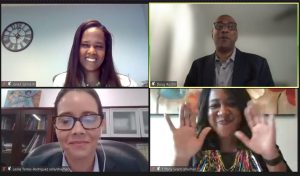UPD’s panel “Turning Stakeholders into Champions” spotlights cutting edge family and community engagement strategies that go beyond online surveys.
We are at a new point in history where “stakeholders” in school districts can no longer only be engaged AFTER decisions are made. The practice of “engagement” needs to change from refreshments and auditoriums to authentically connect community voice with district actions. We need them active upstream to inform decisions and actions if we ever want them to change from “stakeholder” to “champions.”
Right now, we stand at the confluence of so many issues in education in the US: debates over critical race theory, COVID surges causing intermittent closures, to mask or not to mask, required vaccinations or voluntary, and multi-million dollar relief funds flooding into schools.
The experience is profoundly confusing while also deeply human; it’s messy, just like life. For all of us, this new frontier in education requires more involvement, more guidance, more ideas from everyone outside of the school walls – parents, community members, local businesses, community based organizations, etc. – those that have a critical stake in the success of our local schools.
The good news is that there are district leaders around the country vigorously innovating how they engage their communities for making critical plans and taking deliberate action.
We help our clients run authentic community engagement initiatives where power is shared and stakeholders are a part of the design and implementation. We wanted to dig in, learn from, and share what leaders on the cutting edge of this practice are doing to disrupt the stakeholder engagement status quo. Recently, we hosted a panel discussion among district leaders called, “Turning Stakeholders into Champions.” Here’s who joined the conversation:

Janell Ephraim, Chief Equity Officer, Vancouver Public Schools (WA)

Dr. Leslie Torres-Rodriguez, Superintendent, Hartford Public Schools (CT)

Tiffany Grant, former Chief of Staff & District Diversity Officer, San Antonio ISD, now Deputy Director at UP Partnership
Some common themes from the discussion were “going to parents first” before making decisions and not the other way around; doing “whatever it takes” to meet families where they are instead of relying on old forms of engagement; and communication, communication, communication.
Tiffany Grant shared that at San Antonio ISD, school staff went “all in” during COVID distance learning: block-walking and talking at a distance to families on their front porches, phone banking, engaging students in the process to reach out to their peers, safely hosting platicas (small safely distanced gatherings). Awash with devices, new software platforms, and lesson delivery mechanisms, Tiffany and the team learned that SAISD families needed tech help to assist their students learning from home, so they created a Parent Tech Hotline.
Similarly, Dr. Leslie Torres-Rodriguez, Superintendent for Hartford Public Schools (CT), raised the number of home visits from about 2,000 per year to 6,000 during the pandemic. They learned fast that you need to be “aware of survey fatigue” and apply different methods to get community input. Harford also did something that is not common among districts – leaning on and leveraging their relationship with the media. For Dr. Torres-Ridriguez’s and Hartford, transparency is key, and Hartford rolled out their plans through social and traditional media, regularly sharing plans, outcomes, and activities.
Peak pandemic, Vancouver Public Schools (VPS) in Washington State launched an equity audit and equity plan to transform their students’ experiences in schools. Chief Equity Officer Janell Ephraim stressed the importance of one-on-one conversations between staff and multilingual families to address a multitude of issues and questions surveys fail to surface. These carried into focus groups and listening sessions that VPS used to create their equity plan for the district.
The words “Change or Die” marked a turning point in the conversation. Dr. Torres-Ridriguez’s shared that Hartford began including community members upstream, at the beginning of their design process for their initiatives instead of at the end. Pulling from the book Change or Die by Alan Deutschman, Dr. Torres-Ridriguez’s approach to change is to relate, renew, and redo. This is where the conversation really began to take off. Take a listen:
Let’s face it. Being called a “stakeholder” or facilitating “stakeholder engagement” feels pretty dry and bureaucratic.
What we learned in our panel was that some districts are stopping at nothing to engage stakeholders, rarely even using the term to describe the folks in their communities, and engaging them as champions to plan, communicate, and, at times, implement critical changes.
This conversion requires a mindset shift and deliberate action easier said than done. We specialize in supporting districts to make the shift using Design Justice Principles in order to systematize human-centered routines that transform typical engagement sessions into authentic community involvement at the school and district levels. We are incredibly grateful to this panel for sharing their experiences and even more grateful for the impact delivering for student and staff safety and growth in the midst of an unprecedented moment in public education.


Leave a Reply
The comments are closed.